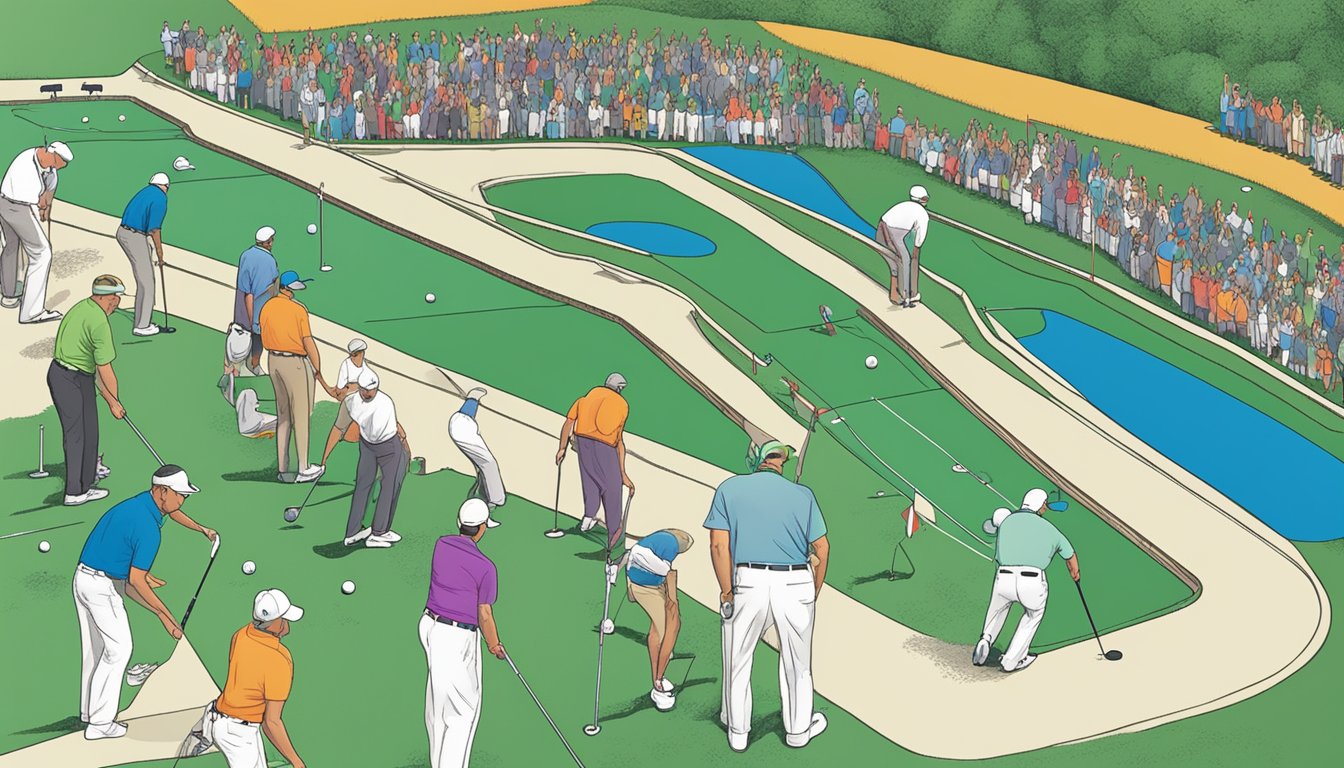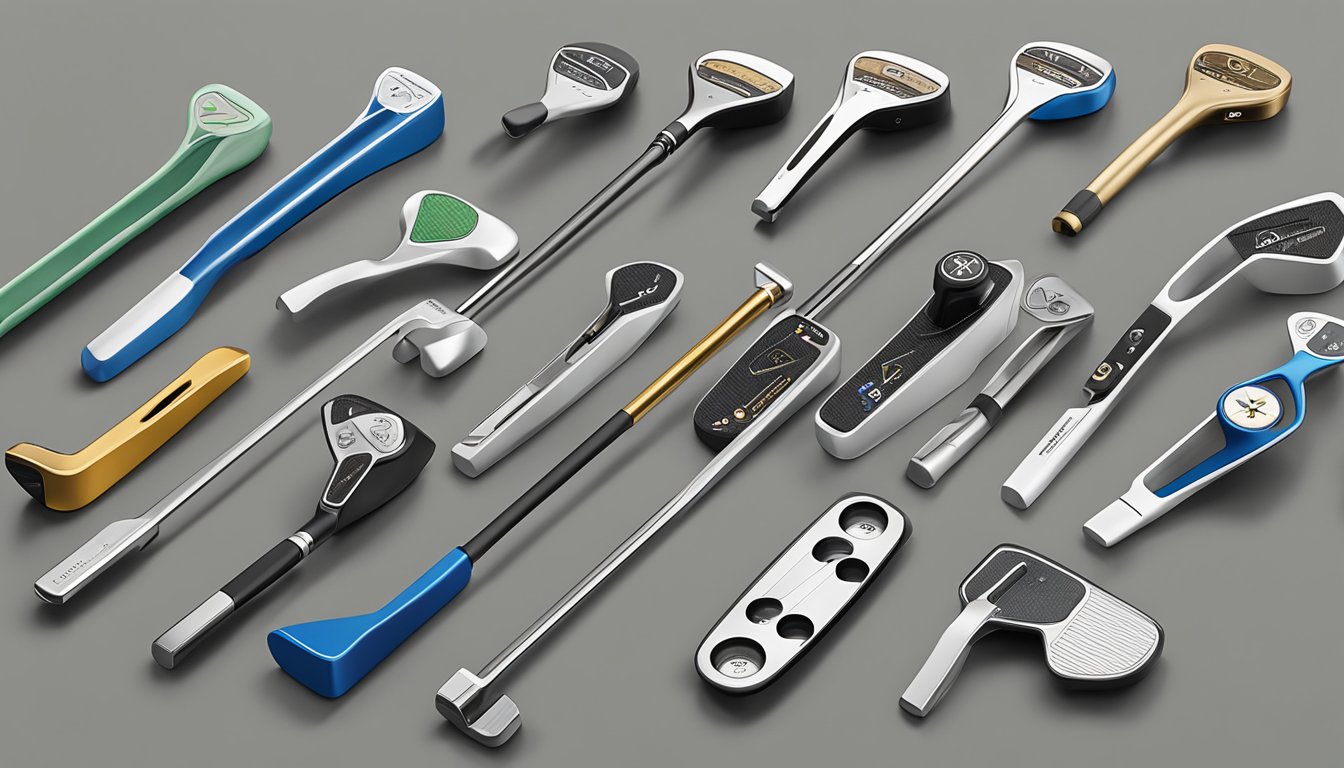Are you looking to improve your putting game? One aspect to consider is the type of putter you use. Sightline, sight dot, and naked putters are three popular options that golfers can choose from. Each type has its own advantages and disadvantages, and finding the right one for you can make all the difference on the green.
Sightline putters have a line or lines on the top or rear of the putter to help with alignment. Sight dot putters have a small dot on the top line of the putter. Naked putters have no alignment aids at all. While sightline and sight dot putters can be helpful for those who struggle with alignment, some golfers find that naked putters allow for a more natural stroke and better feel of the ball. Ultimately, the choice between these types of putters comes down to personal preference and what works best for your game.
When choosing a putter, it’s important to consider the brand and model as well. Some popular options include the Nike Method 001 and Scotty Cameron Newport 2 for sight dot putters, and the Toulon Austin and Artisan 0521 for naked putters. Many professional golfers also have their own preferred putters, which can be seen at major tournaments such as the Masters and U.S. Open. Whether you’re a beginner or a seasoned pro, finding the right putter can help take your game to the next level.
Key Takeaways
- Sightline, sight dot, and naked putters are three popular options for golfers to consider when choosing a putter.
- The choice between these types of putters comes down to personal preference and what works best for your game.
- Popular putter models and brands include the Nike Method 001 and Scotty Cameron Newport 2 for sight dot putters, and the Toulon Austin and Artisan 0521 for naked putters.
Understanding Sightline Sight Dot and Naked Putters
https://www.youtube.com/watch?v=SLTLtrrle0Y&embed=true
When it comes to putting, aim is crucial. That’s where sightline, sight dot, and naked putters come in. These are all different types of alignment aids that can help you line up your putts more accurately.
Sightline Putters
Sightline putters have a line on the top of the putter head that helps you aim. This line can be straight, curved, or angled, depending on the putter model. Some sightline putters also have additional lines on the flange of the putter head to help with alignment. Sightline putters are popular on tour and are often used by professional golfers.
Sight Dot Putters
Sight dot putters have a small dot on the top of the putter head that helps you aim. This dot can be a simple painted dot or a more complex alignment aid, such as a T-shaped dot. Many golfers find sight dot putters less distracting than sightline putters, as they have fewer lines and markings on the putter head.
Naked Putters
Naked putters, also known as “no-line” putters, have no alignment aids on the top of the putter head. This means that you have to rely solely on your own aim and alignment skills to line up your putts. Naked putters are popular among golfers who prefer a clean, minimalist look and who are confident in their putting ability.
Overall, the choice between sightline, sight dot, and naked putters comes down to personal preference. Some golfers find that one type of alignment aid works better for them than another. Custom putter manufacturers such as Toulon Design offer a wide range of putter models with different alignment aids to suit different putting styles.
It’s worth noting that some putters come with an adapter for putters with graphite shafts. This adapter can help to add weight to the putter head, which can improve stability and accuracy on the greens. Some putters also feature tungsten weighting, which can further enhance the feel and performance of the putter.
In summary, when choosing a putter, it’s important to consider the type of alignment aid that works best for you. Whether you prefer sightline, sight dot, or naked putters, make sure to choose a putter that feels comfortable and helps you line up your putts with confidence and accuracy.
Key Putter Models and Brands
When it comes to sightline, sight dot, and naked putters, there are a few key models and brands that stand out from the rest. In this section, we will take a closer look at some of these models and brands.
Tour Preferred Putters
If you’re looking for a putter that has been tested and approved by the pros, then you might want to consider the Tour Preferred putters from brands like Ping and Scotty Cameron. These putters are designed with the input of professional golfers, and they are built to perform at the highest level.
Custom Putters
For those who want a putter that is truly unique, custom putters are the way to go. Brands like Bettinardi, Toulon, and Seemore offer custom putters that can be tailored to your specific needs and preferences. Whether you want a certain type of grip or a specific sightline configuration, these brands can make it happen.
If you’re looking for something truly one-of-a-kind, you might want to check out the Custom Swag putter. This putter is designed and built by hand, and each one is completely unique. Another option is the Two Thumb prototype grip, which is designed to help you maintain a consistent grip and stroke.
In terms of pre-release equipment, keep an eye out for the new Toulon Design Montecito putter. This putter has been spotted on the course and is generating a lot of buzz among golfers.
Overall, there are plenty of options when it comes to sightline, sight dot, and naked putters. Whether you prefer a classic blade or a high-tech mallet, there is a putter out there that is perfect for you.
Golf Tournaments and Player Choices
When it comes to golf tournaments, players have a lot of choices to make, including which putter to use. Some players prefer putters with a sightline, while others prefer sight dots or naked putters. Let’s take a look at some of the choices made by players on the PGA Tour and LPGA Tour.
PGA Tour
At the 2023 RSM Classic, Josh Teater used a Ping S159 wedge and a Ping G430 Max 10K driver, but he chose a naked putter with no sightline or sight dot. Grayson Murray, on the other hand, used a putter with a sightline to help him line up his shots. Chris Kirk used a putter with a sight dot, which he found helpful for his putting game. Ben Kohles also used a putter with a sight dot, which he said helped him line up his shots more accurately.
At the GA PGA Section Championship, Brent Grant used a naked putter with no sightline or sight dot, while Matti Schmid used a putter with a sightline. Paul Haley used a putter with a sight dot, which he said helped him with his alignment.
LPGA Tour
At the Walmart NW Arkansas Championship, Lydia Ko used a putter with a sightline, while K.K. Park used a naked putter with no sightline or sight dot. Pernilla Lindberg used a putter with a sight dot, which she said helped her with her aim. Azahara Munoz used a putter with a sightline, which she found helpful for her alignment.

« Proper maintenance and care for your golf glove: tips for cleanliness and longevity
Wilson Infinite Putter Review: A Comprehensive Look at the Latest Model »
At the Nationwide Children’s Championship, Marina Alex used a putter with a sight dot, while Su Oh used a naked putter with no sightline or sight dot. Alexa Pano used a putter with a sightline, which she said helped her with her alignment.
When it comes to golf tournaments, players have a lot of choices to make, including which putter to use. Whether you prefer a sightline, sight dot, or naked putter, it’s important to choose the putter that works best for you and your game.
Improving Your Game with the Right Putter
https://www.youtube.com/watch?v=SW19ZnDYUTM&embed=true
Choosing the right putter can make a huge difference in your golf game. It’s important to find a putter that feels comfortable in your hands and helps you aim accurately. There are many different types of putters available, including sightline, sight dot, and naked putters. Each type has its own advantages and disadvantages, so it’s important to choose the one that works best for you.
A sightline putter has a line or lines on the top of the putter head that help you aim the putter perpendicular to your target. This can be helpful for golfers who struggle with alignment or have a tendency to push or pull their putts. A sight dot putter has a small dot on the top of the putter head that serves the same purpose as a sightline. Some golfers prefer a sight dot because it is less distracting than a sightline.

A naked putter has no alignment aids on the top of the putter head. This can be helpful for golfers who prefer a clean look and don’t want any distractions when they are lining up their putts. However, it can also be a challenge for golfers who struggle with alignment.
When choosing a putter, it’s important to consider your own preferences and playing style. If you tend to struggle with alignment, a sightline or sight dot putter may be a good choice for you. If you prefer a clean look and don’t need any alignment aids, a naked putter may be a better option. Ultimately, the right putter can help you feel more confident on the green and improve your chances of sinking those important putts.
Remember, choosing the right putter is like an insurance policy for your golf game. It can help you avoid costly mistakes and improve your scores. Take the time to try out different putters and find the one that feels best for you. Happy putting!
Putter Customization and Accessories
https://www.youtube.com/watch?v=HiALHx_yyEE&embed=true
When it comes to golf putters, there are a variety of customization options and accessories that can help improve your game. One popular customization is adding a sightline or sight dot to the putter head. This can help with alignment and accuracy, giving you a better chance of sinking those crucial putts.

In addition to sightlines and sight dots, there are other ways to customize your putter. Some golfers prefer to add weight to the putter head to improve stability and control. Others may choose to adjust the length or grip of the putter to better suit their swing.
Just like with any other club in your bag, it’s important to find the right putter for your game. Experiment with different styles and customization options to find the one that feels best in your hands and helps you make the most putts.
While putter customization is important, don’t forget about the other clubs in your bag. A well-fit driver can help you hit longer and straighter shots off the tee, while the right wedge can help you get up and down from around the green. And of course, choosing the right ball can also make a big difference in your game.
One driver that has been getting a lot of buzz lately is the Cobra Dark Speed Driver. With its sleek design and advanced technology, it’s a great choice for golfers looking to add distance and accuracy to their drives. And when it comes to wedges, there are a variety of options available from all the major manufacturers, each with their own unique features and benefits.
In conclusion, when it comes to golf equipment, it’s important to find what works best for you. Whether it’s a customized putter, a new driver, or a different ball, don’t be afraid to experiment and try new things. With the right equipment and a little practice, you can improve your game and have more fun on the course.
Frequently Asked Questions
What are some popular putter brands besides Sightline, Sight Dot, and Naked?
There are many popular putter brands on the market, including Odyssey, Ping, TaylorMade, and Scotty Cameron. Each brand offers a variety of putters with different designs, features, and price points to suit different preferences and budgets. It’s important to try out different putters and find one that feels comfortable and inspires confidence.
What are some tips for improving your putting accuracy?
Improving your putting accuracy requires practice, patience, and proper technique. Here are some tips to help you improve:
- Keep your eyes over the ball and your head still
- Keep your grip pressure light and consistent
- Use a pendulum-like motion with your arms and shoulders
- Focus on a small target and visualize the ball going in
- Practice different distances and slopes to develop feel and touch
How can you adjust your putter for better alignment?
Alignment is crucial for accurate putting. Here are some ways to adjust your putter for better alignment:
- Check the position of your eyes over the ball
- Use a putter with alignment aids, such as a sightline or dot
- Adjust the lie angle of your putter to match your setup
- Experiment with different grip styles and positions
What is the difference between a mallet and a blade putter?
Mallet putters have larger, more forgiving heads with weight distributed towards the back and perimeter. Blade putters have smaller, more traditional heads with weight distributed towards the face. Mallet putters are generally easier to align and provide more stability on off-center hits, while blade putters offer more feel and control.

What are some common putting mistakes to avoid?
Common putting mistakes include:
- Decelerating on the downswing
- Focusing too much on mechanics and not enough on feel
- Losing confidence after a miss
- Overthinking the putt and taking too long
- Not reading the green properly
What are some drills to improve your putting stroke?
There are many drills you can do to improve your putting stroke, including:
- Gate drill: Set up two tees or clubs on either side of the hole to create a gate and practice hitting putts through it
- Clock drill: Place tees or clubs at different distances around the hole to practice different length putts
- One-handed drill: Practice hitting putts with one hand to develop feel and touch
- Eyeline drill: Use a mirror or alignment aid to ensure your eyes are over the ball and your head is still
Remember, consistent practice and proper technique are key to improving your putting.











